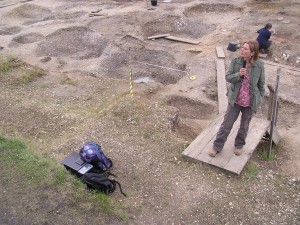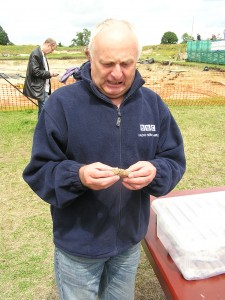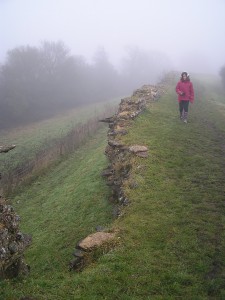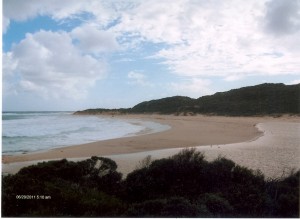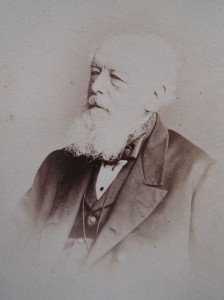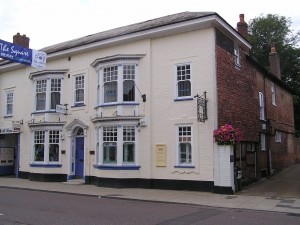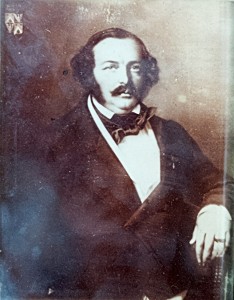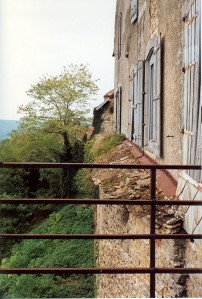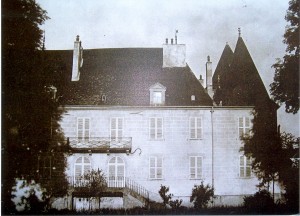Yesterday’s ‘Open Day’ at Silchester, or Calleva Atrebatum to the Romans, was a typically jolly event. Hosted by the University of Reading’s Department of Archaeology, it was an opportunity to view, at close quarters, what is currently the largest archaeological excavation in Britain.
Now in its fifteenth season, the ‘Town Life’ project focuses on a small part of the 170-acre site, the so-called ‘Insula IX’. The insulae are the various quarters of the town, neatly divided by the Roman grid system and numbered by the pioneering Victorian archaeologists for their convenience. Insula IX merits investigation as it stood at the intersection of the main north-south and east-west roads and was densely packed with humble dwellings and workshops, rather than the better-understood public buildings.
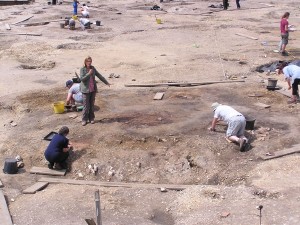 Amanda Clarke, the Field School Director, is pictured (above) beside the north-south road at its fourth-century level. The built-up surface of the street is as solid as concrete but the ground behind her has been dug down to a much lower level, that of the first century. She also points (left) to the well-scorched hearth of a small building of that period, just off the street, which is marvellously evocative. There is speculation that this might have been part of a complex of military buildings. There is also substantial evidence of early round houses in Insula IX, suggesting that the indigenous population lived side by side with their conquerors, but were slow to adapt to the Roman way of life. The team have yet to find a Roman ballista still lodged in the backbone of some unfortunate, such as was famously discovered at Maiden Castle, but they live in hope.
Amanda Clarke, the Field School Director, is pictured (above) beside the north-south road at its fourth-century level. The built-up surface of the street is as solid as concrete but the ground behind her has been dug down to a much lower level, that of the first century. She also points (left) to the well-scorched hearth of a small building of that period, just off the street, which is marvellously evocative. There is speculation that this might have been part of a complex of military buildings. There is also substantial evidence of early round houses in Insula IX, suggesting that the indigenous population lived side by side with their conquerors, but were slow to adapt to the Roman way of life. The team have yet to find a Roman ballista still lodged in the backbone of some unfortunate, such as was famously discovered at Maiden Castle, but they live in hope.
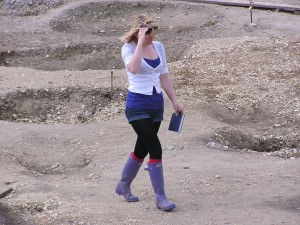 There is an air of Glastonbury surrounding the tented village that arises here each summer. I was amused to see that some of the young and attractive team of diggers (see left) have been daring enough to pose naked for a calendar – ‘without the permission of Reading University’. All profits from Naked Archaeologists are donated to the Silchester Town Life Project and the Inner Hebrides Archaeological Project, in which they are also involved. I particularly like the picture for May. Five girls, clearly perishing cold on what was presumably an early-morning photo-call, are gazing into the city from the south wall. Their shivering backs are adorned with intricate spiral patterns of woad. The caption wittily reads: ‘Boudicca and her warriors plan their attack on the Roman town’. The tableau is historically accurate. According to Roman writers, the Ancient Britons daubed themselves with woad and charged naked into battle. There is also evidence of destruction at Silchester at the exact time of the Boudiccan revolt. I hope these girls know the correct pronunciation of her name: Bow-deeka.
There is an air of Glastonbury surrounding the tented village that arises here each summer. I was amused to see that some of the young and attractive team of diggers (see left) have been daring enough to pose naked for a calendar – ‘without the permission of Reading University’. All profits from Naked Archaeologists are donated to the Silchester Town Life Project and the Inner Hebrides Archaeological Project, in which they are also involved. I particularly like the picture for May. Five girls, clearly perishing cold on what was presumably an early-morning photo-call, are gazing into the city from the south wall. Their shivering backs are adorned with intricate spiral patterns of woad. The caption wittily reads: ‘Boudicca and her warriors plan their attack on the Roman town’. The tableau is historically accurate. According to Roman writers, the Ancient Britons daubed themselves with woad and charged naked into battle. There is also evidence of destruction at Silchester at the exact time of the Boudiccan revolt. I hope these girls know the correct pronunciation of her name: Bow-deeka.
A more questionable image is that for November. Entitled ‘An evening of bar sports in the Calleva Arms’, a naked man, snooker queue in hand, cocks his leg over the side of the table and leans over it as he aims his shot. The Calleva Arms is a family pub so let’s hope the picture was taken out of hours. Otherwise the images are very tasteful, and all the models are undoubtedly good sports.
In this picture, Roger Hammett of BBC Learning, based at Southampton, handles a sample of Roman ‘poo’ with a fine air of professional detachment. I hope he was duly grateful to his assistant, Sophia,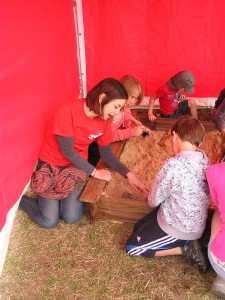 who had spent hours, the previous day, kneading these unsavoury objects into shape. Introducing passing children to the thrill of archaeology in a sandpit, Sophia (right) showed a considerable knack of engaging with them and instructed them expertly in the significance of their various ‘finds’.
who had spent hours, the previous day, kneading these unsavoury objects into shape. Introducing passing children to the thrill of archaeology in a sandpit, Sophia (right) showed a considerable knack of engaging with them and instructed them expertly in the significance of their various ‘finds’.
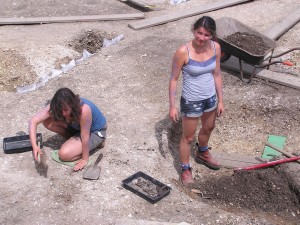 Here Hannah, a budding Oxford Classicist, pauses to rest during a bout of energetic digging, having just nonchalantly excavated a substantial part of the rim of a large bowl. Roman Silchester had a strikingly youthful population, few of whom would have lived beyond the age of thirty. It is touchingly appropriate that their modern counterparts should be uncovering their lives with such energy, grace and commitment.
Here Hannah, a budding Oxford Classicist, pauses to rest during a bout of energetic digging, having just nonchalantly excavated a substantial part of the rim of a large bowl. Roman Silchester had a strikingly youthful population, few of whom would have lived beyond the age of thirty. It is touchingly appropriate that their modern counterparts should be uncovering their lives with such energy, grace and commitment.
See also my previous blog on Roman tilers and their literacy in Calleva Atrebatum.
